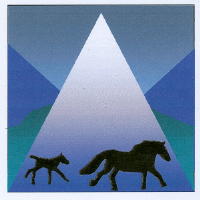Acknowledging Rose and Her Pre-Flight Checks
/One of my earliest memories of my first Fell Pony Sleddale Rose Beauty makes me chuckle now, though at the time it was definitely Beauty who was doing the chuckling. I had gone out to handle her feet, and I was using the technique that was working on my other (non-Fell) ponies. Beauty, though, had absolutely no interest in cooperating with my approach, though I knew she knew what I wanted. I could pull her feet off the ground by pulling on her feather, but I couldn’t get her to lift them for me. Eventually, Beauty was one of my favorite hoof trimming objects because she was so cooperative, but that first time, I was the one getting the lesson about how things should go.
“What’s next?!!”
As I have been bringing my mare Willowtrail Wild Rose back into work, I have often thought back to other ponies in her line that I have worked with in the past. In addition to her mother Beauty, I worked with her half-sister Lily. When I went back and re-read things I wrote about working with Beauty and Lily, I chuckled with recognition. Rose is definitely of that line!
In the last few days, Rose’s attitude towards me has definitely changed to one of intense interest in what we might do together. The photo here shows her in that frame of mind. What got us to this rewarding point was acknowledging Rose like I used to acknowledge her mother and doing pre-flight checks like I used to do with her sister. To read about acknowledging Beauty, click here. To read about Lily’s pre-flight checks, click here.
After I met my friend and mentor Joe Langcake, I asked him about Beauty’s type of cooperation. He replied that he had owned a Sleddale mare once, and he had got shot of her because she was too much work; she took too much effort to bring along. Christine Robinson of the Kerbeck Stud acknowledges that ‘they are certainly independent,’ but they have a type of physical package – legs and feet, bone and substance, broad back and wide chest – that make them worth the effort. Christine has said, ‘I found all our [Sleddale] ponies were really willing to please and good workers.” (1) Joe acknowledged that when he later saw his former Sleddale pony at a show, he was very impressed with her.
When Rose was born, I thought that now I might have a pony in that line that I could work with. I so loved Beauty’s type that it is a conservation goal of mine to keep it going since the Sleddale ponies are no longer being bred. Rose is definitely of that line, but she also is willing to be a good worker, as long as I acknowledge her and pass her pre-flight checks!
Morrissey, Jenifer. “The Sleddale Fell Ponies and Mr. Henry Harrison,” Fell Pony Express Volume 11 Number 2, Fall/Winter 2012, Fell Pony Society of North America, p. 10.
© Jenifer Morrissey, 2020
There are lots of stories about Rose’s relations in my book What an Honor, available internationally by clicking here or on the book cover.






















































